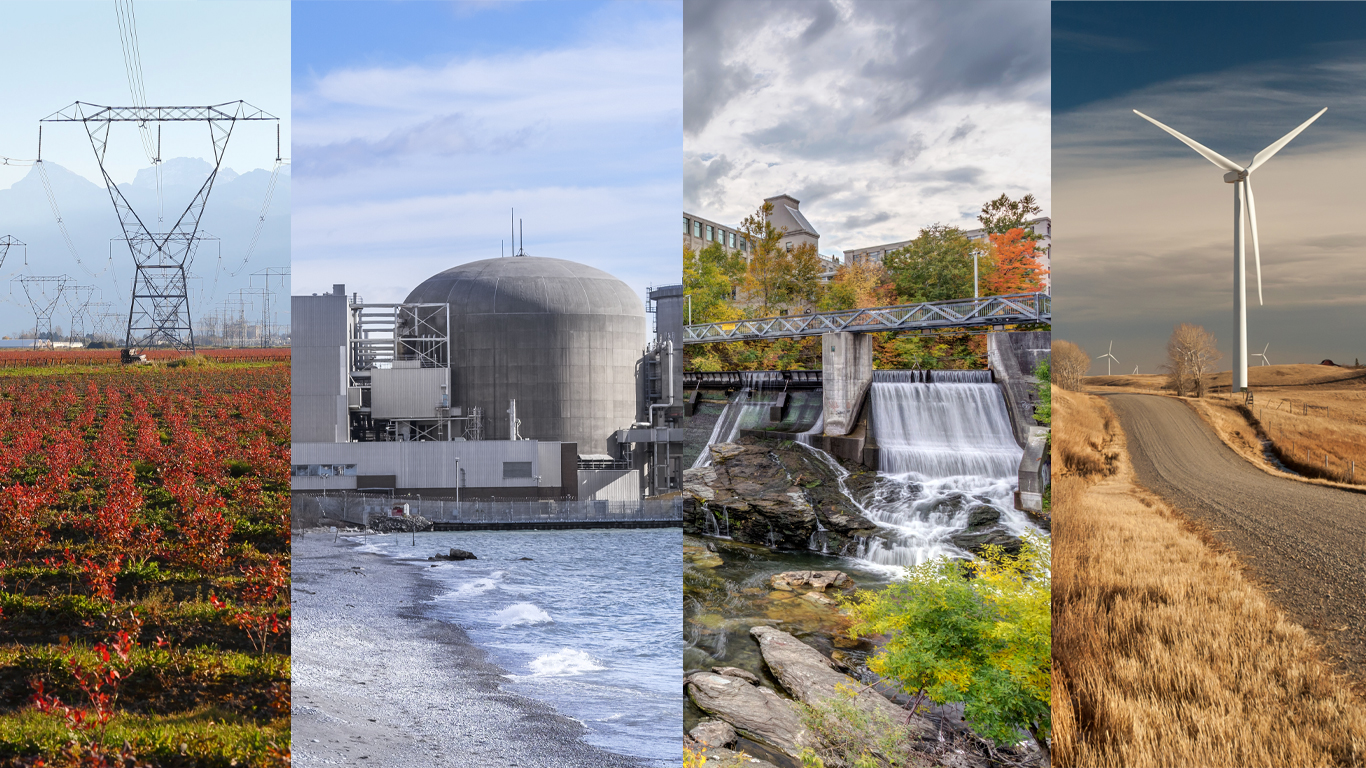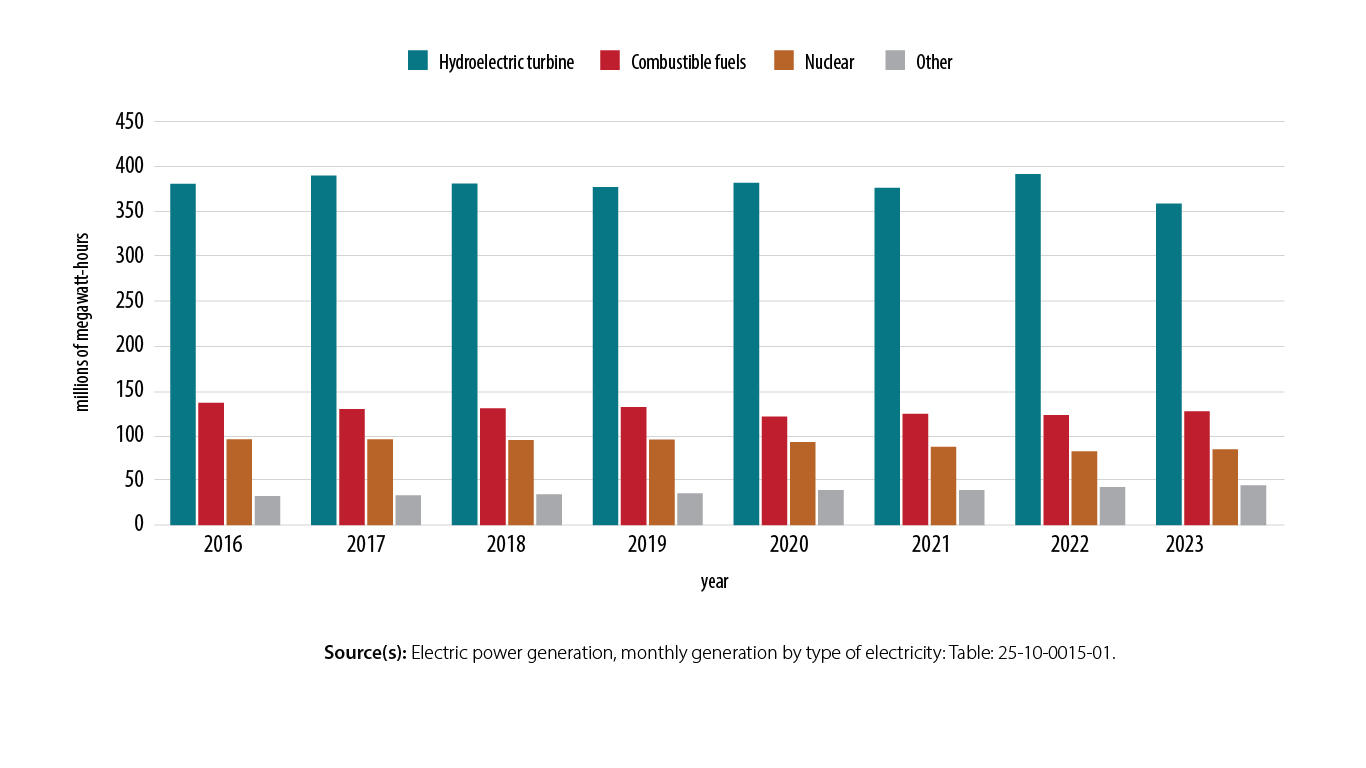
Total electricity generated in Canada fell 3.9% year over year to 615.3 million megawatt-hours (MWh) in 2023. For reference, 1 MWh of electricity is equivalent to the power needed to light two 60-watt bulbs for an entire year. Overall, 2023 marked the lowest level of electricity generation since changes were introduced to this data series in 2016, which is notable considering that additional generating capacity comes online every year. Nearly all of the decline in electricity generation in 2023 was weather-related.
Three-fifths of Canada’s electricity comes from water
Canada’s electricity system is highly reliant on hydroelectricity. From 2016 to 2022, Canada generated on average three-fifths (59.9%) of its total annual electricity from hydroelectric generating stations. For this reason, the supply, demand and trade of Canada’s electricity systems are indelibly linked to weather.
The summer 2023 was the hottest summer on record since 1940, according to Environment and Climate Change Canada, and Western and Central Canada received below- or well-below-average amounts of precipitation, putting a strain on hydroelectricity generation and exports.
Hydroelectricity (-8.4% to 359.3 million MWh) was the largest contributor to the national decline in electricity generation in 2023. While hydro is renewable and generally a reliable source of electricity, it is susceptible to persistent dry conditions. In 2023, three of Canada’s largest hydroelectricity generators, that is, Quebec (-9.3%), British Columbia (-21.5%) and Manitoba (-12.1%), were afflicted by drought or abnormally dry conditions and saw electricity generation drop as a result.
Chart 1: Electricity generation in Canada, by source

Description - Electricity generation in Canada, by source
The title of the chart is “Electricity generation in Canada, by source.”
This is a grouped bar chart.
The vertical axis shows the generation of electricity in millions of megawatt-hours, from 0.00 to 450.00 by increments of 50.00.
The horizontal axis shows 32 bars. Their labels, from left to right, are the years 2016, 2017, 2018, 2019, 2020, 2021, 2022, and 2023. Each year has four bars, showing generation from hydroelectric turbine, combustible fuels, nuclear, and other sources, which includes wind and solar.
For 2016, hydroelectricity generation was 381.41 million megawatt-hours. Generation from combustible fuels was 136.73 million megawatt-hours. Generation from nuclear was 95.69 million megawatt-hours. Generation from other sources was 32.46 million megawatt-hours.
For 2017, hydroelectricity generation was 390.75 million megawatt-hours. Generation from combustible fuels was 129.72 million megawatt-hours. Generation from nuclear was 95.74 million megawatt-hours. Generation from other sources was 33.16 million megawatt-hours.
For 2018, hydroelectricity generation was 381.64 million megawatt-hours. Generation from combustible fuels was 130.51 million megawatt-hours. Generation from nuclear was 95.04 million megawatt-hours. Generation from other sources was 34.28 million megawatt-hours.
For 2019, hydroelectricity generation was 377.64 million megawatt-hours. Generation from combustible fuels was 131.86 million megawatt-hours. Generation from nuclear was 95.47 million megawatt-hours. Generation from other sources was 35.42 million megawatt-hours.
For 2020, hydroelectricity generation was 382.62 million megawatt-hours. Generation from combustible fuels was 121.35 million megawatt-hours. Generation from nuclear was 92.65 million megawatt-hours. Generation from other sources was 38.95 million megawatt-hours.
For 2021, hydroelectricity generation was 376.99 million megawatt-hours. Generation from combustible fuels was 124.20 million megawatt-hours. Generation from nuclear was 87.38 million megawatt-hours. Generation from other sources was 39.09 million megawatt-hours.
For 2022, hydroelectricity generation was 392.35 million megawatt-hours. Generation from combustible fuels was 123.04 million megawatt-hours. Generation from nuclear was 82.30 million megawatt-hours. Generation from other sources was 42.40 million megawatt-hours.
For 2023, hydroelectricity generation was 359.29 million megawatt-hours. Generation from combustible fuels was 127.02 million megawatt-hours. Generation from nuclear was 84.57 million megawatt-hours. Generation from other sources was 44.47 million megawatt-hours.
One-fifth of our electricity came from burning “stuff,” mostly fossil fuels
Canada’s second leading source of electricity generation is combustible fuels, which include natural gas, coal, fuel oil, diesel and biomass, such as wood. Combustible fuel electricity generation rose 3.2% year over year to 127.0 million MWh in 2023, accounting for 20.6% of total electricity generation.
In 2023, 13.7% of Canada’s electricity mix came from nuclear energy
Nuclear energy was Canada’s third most important electricity source in 2023. Canada has four nuclear generating stations: Bruce, Darlington and Pickering in Ontario and Point Lepreau in New Brunswick. Total generation from nuclear energy was up 2.8% year over year to 84.6 million MWh in 2023.
Wind and solar on the rise
Generation from wind and solar sources represented 7.2% of Canada’s total electricity in 2023. However, these renewable sources of energy generation are growing and provided Canada with 37.4% more electricity in 2023 than in 2016. In 2023, wind generated 39.7 million MWh while solar generated 4.7 million MWh.
Electricity exports fall by one-quarter
Canada’s weather in 2023 had perhaps the most noticeable impact on electricity trade. Canada is a net electricity exporter, with Quebec, Ontario, British Columbia and Manitoba usually accounting for the bulk of exports.
In 2023, exports of electricity to the United States, Canada’s sole electricity trading partner, fell 24.4% year over year to 49.4 million MWh, the lowest level since changes were introduced to this data series in 2016.
Ontario surpassed Quebec in electricity exports in 2023
Quebec is generally Canada’s largest electricity exporter. In 2023, however, exports from Quebec fell 41.1% year over year to 13.3 million MWh, as the province dialled back electricity exports to maintain water levels in hydroelectric reservoirs. As a result, Ontario (13.9 million MWh) became the largest exporter of electricity in 2023, despite shipping 11.5% less electricity to the United States compared with one year earlier.
British Columbia saw electricity exports fall 45.3% year over year to 6.6 million MWh in 2023. Parts of the province received record low precipitation in 2023, which left some of its hydroelectric reservoirs abnormally low.
As of December 31, 2023, about 88% of British Columbia was classified by Agriculture and Agri-food Canada as "abnormally dry or drought-stricken". Dry conditions also reduced exports from Manitoba (-31.1% to 7.2 million MWh).
British Columbia imports more electricity in midst of drought
Canada’s electricity imports rose 54.2% year over year to 21.7 million MWh in 2023, the highest imports since this series was redesigned in 2016. British Columbia accounted for the vast majority (77.3%) of 2023 imports.
Looking ahead
The Canada Energy Regulator projects that total electricity use could more than double by 2050. As our reliance on electricity grows, the year 2023 can provide a glimpse into the challenges that Canada’s electricity system may face more frequently due to climate change.
To learn more about electricity data, check out the Canadian Centre for Energy Information’s electricity dashboard. To follow electricity data throughout the year, keep an eye on the monthly Energy Statistics release.
Other energy 2023 year in review articles include:
- Published March 7, 2024 - Record high crude oil production largely driven by oil sands: Crude oil year in review 2023
- Published March 12, 2024 - Canadian petroleum product refining returns to pre-pandemic levels: Refined petroleum products year in review 2023
- Published March 14, 2024 - Record natural gas production driven by industrial deliveries – Natural gas year in review 2023.

StatsCAN app
Did you know you can read StatsCAN Plus articles and more on the StatsCAN app? If you’re already using the app, let us know what you think by leaving a review in the App Store and Google Play.
Contact information
For more information, contact the Statistical Information Service (toll-free 1-800-263-1136; 514-283-8300; infostats@statcan.gc.ca) or Media Relations (statcan.mediahotline-ligneinfomedias.statcan@statcan.gc.ca).
